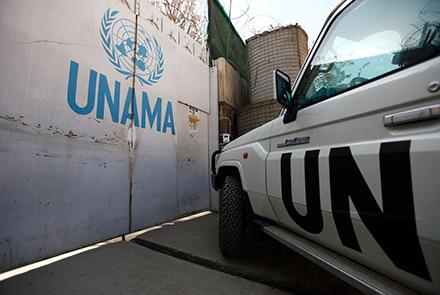The number of civilians killed and injured in the Afghanistan conflict during the first six months of 2017 persisted at the same record high levels as last year, according to a mid-year report from the United Nations.
A statement issued by the organization said: “Extreme harm to civilians continued amid a worsening toll from suicide attacks, and a greater impact on women and children.”
A total of 1,662 civilian deaths were confirmed between 1 January and 30 June – an increase of two percent against the same period last year, according to figures from the UN Assistance Mission in Afghanistan (UNAMA).
The number of civilians injured in the same period fell one percent to 3,581.
“The human cost of this ugly war in Afghanistan – loss of life, destruction and immense suffering – is far too high,” said Tadamichi Yamamoto, the Secretary-General’s Special Representative for Afghanistan and head of UNAMA.
“The continued use of indiscriminate, disproportionate and illegal improvised explosive devices is particularly appalling and must immediately stop,” he said.
The report highlights that 40 per cent of all civilian casualties during the six-month period were killed or injured by anti-government forces using improvised explosive devices (IEDs), such as suicide bombs and pressure-plate devices, which were responsible for the deaths of 596 civilians and injured 1,483.
These figures include civilian casualties from suicide and complex attacks - involving more than one perpetrator and two or more forms of weaponry, including suicide IEDs - which killed 259 civilians and injured 892, a 15 percent increase on comparable figures for the first six months of 2016.
“Many of those casualties occurred in a single attack in Kabul city on 31 May, when a truck bomb killed at least 92 civilians and injured nearly 500, the deadliest incident documented by UNAMA since 2001,” the UN statement read.
The report meanwhile made a series of recommendations, including a call to anti-government forces to stop targeting civilians and to enforce directives from the Taliban leadership calling for an end to such attacks.
“Government forces are urged to stop using weapons including mortars and rockets in civilian populated areas, and to disband pro-government militias and similar groups. The report also recommends ongoing support from international military forces to support and train the Afghan national army,” read the statement.
The UN High Commissioner for Human Rights, Zeid Ra’ad Al Hussein, said: “The statistics in this report, horrifying though they are, can never fully convey the sheer human suffering of the people of Afghanistan. Each one of these casualty figures reflects a broken family, unimaginable trauma and suffering, and the brutal violation of people’s human rights.
“Many Afghan civilians are suffering psychological trauma, having lost family and friends, and are living in fear knowing the risks they face as they go about their daily lives. Many more have been forced from their homes and suffered lasting damage to their health, education and livelihoods. The continuing national tragedy of Afghanistan must not be overlooked,” Al Hussein said.
The figures show a rise in the number of women and children killed and injured, reversing a decline documented in 2016. A total of 174 women were confirmed as killed and 462 injured, an overall rise in casualty figures of 23 per cent on the same period last year.
Child casualties increased by one per cent, with 436 deaths and 1,141 injuries recorded, although the number of child deaths was up by nine percent. UNAMA noted that the use of pressure-plate IEDs and aerial operations in civilian-populated areas substantially contributed to the increases in both women and child casualties.
Anti-government forces caused the deaths of 1,141 civilians and injury of 2,348, a 12 percent increase on the first six months of last year. These deaths and injuries represent 67 percent of the total number of civilian casualties, with 43 percent attributed to the Taliban, five percent to Daesh and the rest to unidentified attackers.
UNAMA attributed a total of 327 civilian deaths and 618 injuries to pro-government forces, a 21 percent decrease compared with the same period last year, although UNAMA noted a 43 percent rise in civilian casualties during aerial operations (95 deaths and 137 injuries).
Nineteen percent of the casualties occurred in the capital, Kabul, as a result of suicide and complex attacks. Civilian casualties increased in 15 of Afghanistan’s 34 provinces, mainly due to increased attacks by anti-government forces. The highest numbers of casualties occurred in Kabul, Helmand, Kandahar, Nangarhar, Uruzgan, Faryab, Herat, Laghman, Kunduz and Farah provinces.
Click here for the full report.


